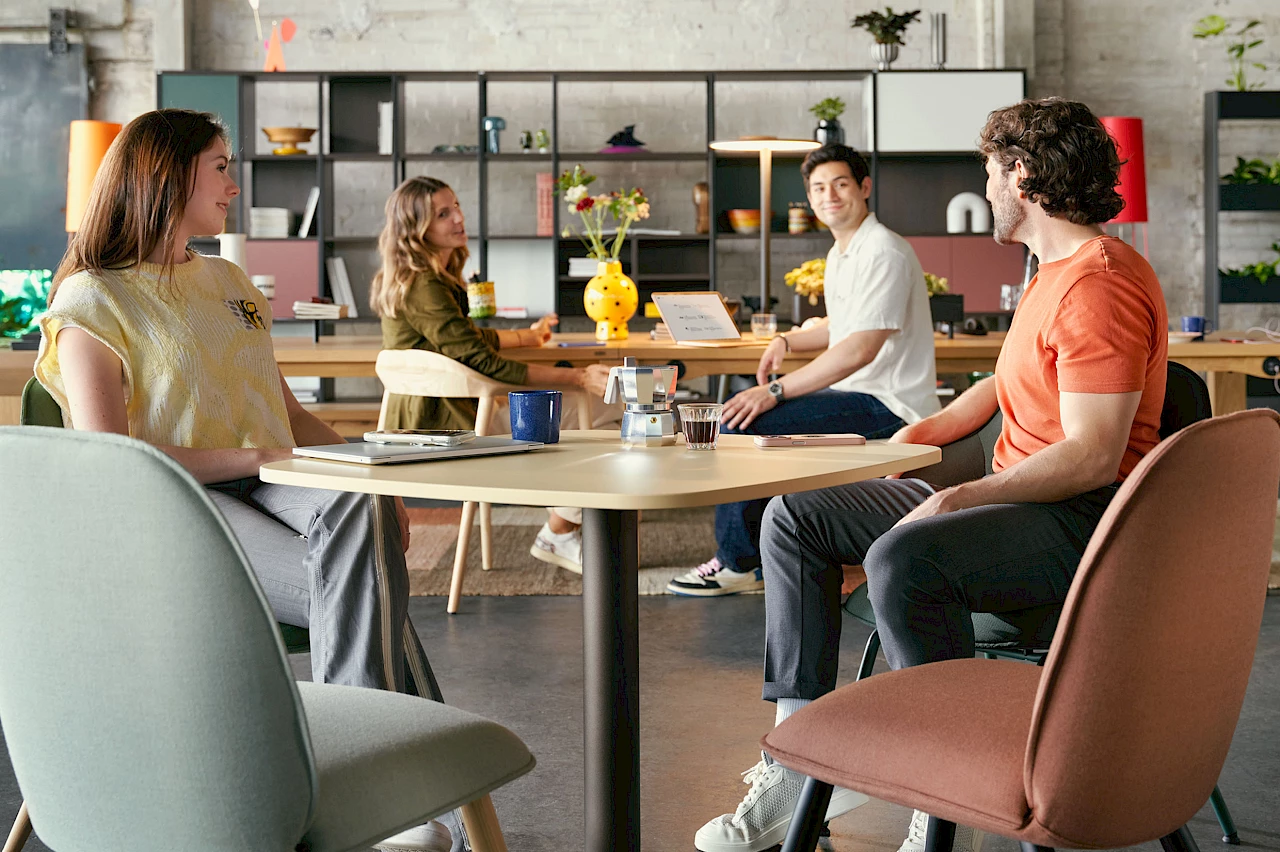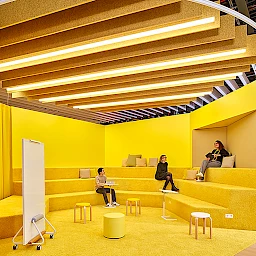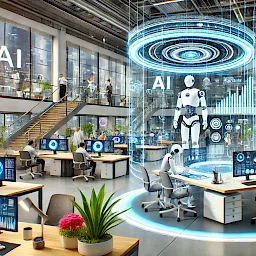How should offices be designed so that they are not only functional, but also promote health, team spirit and creativity? This question took centre stage in several discussions at the Work Culture Festival 2024 and it continues to gain importance. That’s because current scientific findings show that spaces have a greater influence on our well-being and performance than has long been assumed.
Successful working environments are evidence-based and participative
At the festival, Amelie Marie Fischer and Ann Sophie Lauterbach from the Future of Work Lab Konstanz emphasised that successful working environments are evidence-based and participative. Instead of concentrating exclusively on spatial efficiency, the focus is increasingly shifting to user-centricity. Studies show that acoustic and visual privacy, the indoor climate, light and ergonomic workstations are decisive factors for well-being and productivity. Flexible, activity-based working environments that are tailored to different needs not only promote collaboration, but also increase the innovative strength of teams. It’s especially important to involve employees at an early stage, promote psychological ownership and introduce changes gradually. After all, workspaces should remain dynamic and adapt to changing needs.
Design for Life: Spaces that connect and empower
The Design for Life panel of design experts discussed what such spaces could look like in concrete terms. Their approach is that workplaces should no longer be purely functional spaces, but instead be designed as living spaces that enable encounters, mindfulness and personal development. Common rituals, such as intentional breaks, creative transitions between work phases or small mindfulness exercises in everyday life, play a central role in this. They help teams to stay connected, reduce stress and recharge their batteries. At the same time, the experts emphasized the importance of spaces that allow for individual forms of expression: places where thoughts can become visible, processes can grow and personal needs are taken seriously. This is how real places of power arise in the hybrid work routine.
Healing architecture: Health-promoting spaces
The concept of healing architecture shows that rooms do not just have to be functional, but can actively contribute to health. Interior designer Charleen Grigo advocates working environments that make targeted use of light, acoustics, materials and atmosphere to support physical and mental well-being. Numerous studies have shown that our environment unconsciously influences our emotions, concentration and regeneration. Factors such as natural daylight, biodynamic lighting, pleasant room acoustics and selected materials have a calming effect and promote resilience. Particularly in view of the increasing stress levels in hybrid working environments, it is becoming crucial to create places that enable both activation and relaxation. Healing architecture sees office design as a living system that responds flexibly to people’s needs, with places of retreat, variable lighting moods and zones for concentration or creativity. This turns the office into a place that promotes health, motivation and quality of life in equal measure. But spaces alone cannot solve all challenges. Equally important is a culture that actively supports mental health and integrates it into daily life.
Mental health: Prevention begins in everyday life
A healthy working environment doesn’t end with the design of the rooms. Mental health should also be an integral part of the corporate culture. This is emphasised by psychologists Dr Eva Elisa Schneider and Nora Dietrich. According to them, prevention doesn’t start with mindfulness courses or feel-good activities, but with the basic structures of everyday working life. This includes trusting leadership, psychological security in the team and real freedom for employees to shape their own work. Then spaces and culture work hand in hand. Creating zones for concentrated work and relaxation promotes mental health, as do social meeting places for exchange and encounters. It is crucial that health is not seen as an individual issue, but as a joint task. Serious offers, retreat spaces and an open culture of discussion help to reduce stress at an early stage and strengthen resilience in teams. This creates an environment in which people not only remain productive, but can also develop in the long term and realise their full potential.
Art: A catalyst of change
Art also plays an important role when it comes to making workplaces livelier, more human and more creative. Art curator Viviane Mörmann emphasises that “Art in the workplace is not a nice extra, but can open up perspectives, initiate change and make corporate values visible.” Formats that actively involve employees, such as co-creation projects, interactive installations or participative workshops, are particularly effective. Art creates resonance spaces for dialogue and development — and thus becomes a strategic building block of modern corporate culture. At the panel Why Art and Work Belong Together, moderated by theatre maker Nicola Bramkamp, it also became clear that art is far more than just decoration. It is a source of inspiration for creativity, encounters and change. Art opens up new spaces for thought, challenges routines and promotes a culture of changing perspectives. It is precisely where art irritates and doesn’t aim for consensus that spaces are created for genuine debate and innovation. Art makes it possible to endure uncertainties, develop new narratives and unleash creative potential — important prerequisites for a lively and adaptable corporate culture.
Designing atmospheres: Sound, light and social dynamics
Sound also shapes how we experience workspaces. At the Work Culture Festival, Austrian composer and audio branding expert Walter Werzowa explained the power that music can have on well-being, concentration and social interaction. Used correctly, music can reduce stress, promote mental alertness and strengthen emotional bonds, whether through soundscapes, listening to music together or consciously designed sound zones. It’s not about continuous sound, but about subtle staging: soundscapes should support situations and appeal to people emotionally without overwhelming them. Light also plays a key role. Natural daylight, biodynamic lighting and lighting concepts adapted to the course of the day have a demonstrably positive effect on mood, health and productivity. Deliberately designed meeting places, such as lounge areas or interactive cafeterias, complement these atmospheres.
Identification instead of standard solutions
Architect Peter Ippolito put it in a nutshell: an office is not just a place to work, but an expression of an organisation’s identity. It should be able to react flexibly to changes, allow for diversity and offer opportunities for real encounters. Standard solutions don’t go far enough. Successful spatial concepts are created in a dialogue with the people who use them and continue developing with them. At the same time, according to Ippolito, modern working environments must be designed to be sustainable: durability, adaptability and resource-saving concepts are increasingly becoming the measure of sustainable office design. It’s about creating spaces that enable genuine encounters and unplanned interactions, because innovation often arises where people meet by chance and develop new perspectives.
In other words, successful working environments are multi-sensory, participative and people-centric. They boost health, creativity and social ties. They create space for personal expression as well as for communal experiences. And they see spaces not as rigid structures, but as living systems that turn work into a holistic experience. Or, as it was expressed at the Work Culture Festival: workplaces should not be designed for work, but designed for life.




 Jasmin Najiyya
Jasmin Najiyya 

